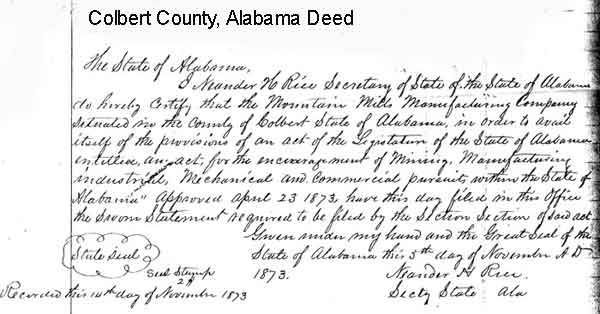
COLBERT COUNTY, ALABAMA
HISTORY
MOUNTAIN MILLS
Written and Contributed by
Lewis C.
Gibbs, Jr.
THE HISTORY OF MOUNTAIN MILLS
By Lewis C. Gibbs, Jr.
Around
1835, after the Indians were moving to Indian Territory in Oklahoma, the whites
began to buy the land west of Caney Creek, the boundary line.
Armstead Barton was the
oldest son of Dr. Hugh Barton, one of ten children. He was also Governor of the
Mississippi Territory. In this position he became friend to the Colberts, who
were leaders of the Chickasaw Indians. Through this friendship, he came into
possession of most of the land in the western part of what is now Colbert
County.
His brother, Arthur C.
Barton, came into possession of most of the land around Barton, Alabama, or
range 13 and township 4. The rest of the land in this area was bought by the
Prides, the Thompsons, the Rutlands, W. W. Bayless, Hextor Atkisson, the Gibbs
brothers (Alexander and Jack or J. E. Sr.) and the Greenhills.
The Hextor Atkinson
family lived near the site of the future Mountain Mill Industry Village. The
Bayless family lived about a mile east; the Thompson and Rutland families a mile
east and south; the Prides about two miles east and A. C. Barton two miles
north.
The Hexton Atkisson
family consisted of nine children, eight girls and one boy. Bob Garner married
one of the girls. Another girl married three times, Mr. Moore, Mr. Donley, and
Mr. Whitley. The son married twice, Susan Danley and Lucy Sherrod. His name was
Arthur Atkisson. Two of the sisters never married and they out-lived all of
them. They later lived at the James S. Barton home which was owned by John
Whitley, a nephew. Not only a landowner, Hextor Atkisson was a Justice of the
peace for many years. His wife was named Sally Franklin and was said to be from
the same family as Ben Franklin. W. W. Bayless was also a Justice of the peace
and a large land owner.
INDUSTRY BEGINS
Capt. J.
S. Stickels was from the North and connected with steam boating on the Tennessee
River before the War between the States, but fought for the South in the war. He
was married to Elizabeth Olds, a niece of Mrs. Hextor Atkisson. It is said that
he was a brave and courageous soldier and was a gallant defender of the South.
He was born April 19, 1827, and died April 5, 1883. His grave was marked in the
fall of 1995 in the Atkisson Cemetery.
After the war was over,
J. H. Stickels and James Johnston put in a sawmill near the Mountain Mill
Village. This mill was powered by steam. Later they put in a grist mill. It was
a practice then to use this machinery on Saturday to grind meal. There were two
different engines, run by the same boiler.
At a later date, a
foundry and machine shop were installed. James Wright was brought in as a
pattern maker and machine shop man. He had been in this business all through the
war at Florence, Alabama, near where Mars Hill Bible School is today. All of
these operations were successful.
Asa Messenger, publisher
of the North Alabamian and other publications was encouraging Southerners to
start manufacturing their own goods. This would save the high tariff on raw
material shipped to the north and the shipping cost to ship the finished product
back.
In 1872 the group of men
mentioned above, along with N. F. Cherry and others, organized the Mountain Mill
Company. Their purpose was to build a cotton mill to make thread from cotton and
maybe cloth and other items also.

N. F. Cherry was born in
Hardin County, Tennessee, near Savannah. The ten years before coming to Mountain
Mills had been spent in merchandising and steam milling.
The Mountain Mill Company
started with seventy-five thousand dollars ($75,000) in stock. A corporation was
formed under the laws of Alabama. Shares were sold to local people. It is said
that every rich person in the county bought stock in the company.
The factory was built and
machinery from New Jersey was bought and installed. It is said that the
machinery was used. The building was a three-story brick and we think it was
about 100 feet by 200 feet, with boiler room and engine room attached, with
about a 100-foot smoke stack. After the machinery was installed they began to
hire people to operate the mill.
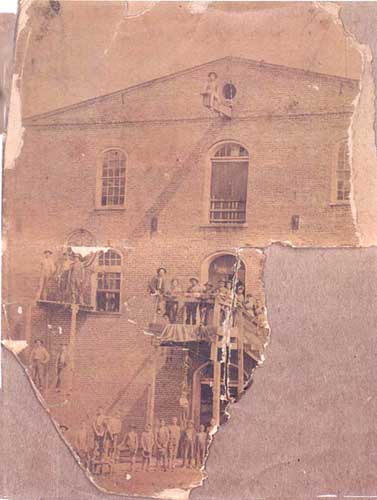
Mountain Mills Factory
Some of these families
are still in this area, the Blankenships, Burrows, Hargetts, Inmans, Keetons and
others. These families consisted mostly of girls. Women and children were used a
lot in operating the mill. They also built a company store or commissary. Mr.
Houston Ramsey was brought in to operate this business. He is referred to in the
East Florence story. Homes for the people and a church and school were built.
They built one building and used it for church and school. This building is
still in use today in the Barton area by a black congregation.
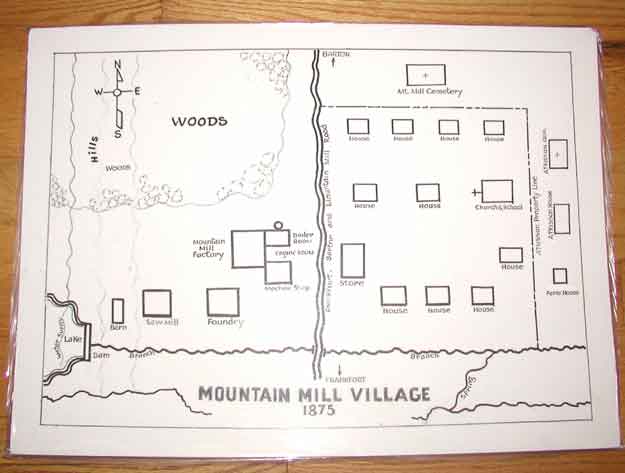
Some of the preachers
that preached at Mountain Mill were E. C. Fuqua, J. D. Tant and others. A
professor Blaylock was brought in to run the school. Another teacher was E. C.
Hamilton.
|
|
Edward C. Fuqua |
A small town of about
three hundred people came together around the mill. It was written that there
was no need for law enforcement or courts.
In 1874, more money was
needed. Twenty-five thousand dollars in bonds was floated with the German
National Bank of Memphis, Tennessee, at 10% interest, payable every six months.
The company operated for
twelve years, but seemed to be in financial trouble all the time. Miss Nina
Leftwich stated in her book “Two Hundred Years in Muscle Shoals” that this was
due to the used machinery that was installed when the operation started.
In 1883, the German
National Bank foreclosed on the Mountain Mill Company. We have no record of
their closing. We assume that W. N. Cherry bought their stock or debt. On April
7, 1883, W. N. Cherry bought out Arthur C. Barton and W. W. Bayless for
$9,100.00. Miss Nina Leftwich said it sold for 5% of the original investment.
After this W. N. Cherry
formed a partnership with N. F. Cherry and C. N. Brandon. Mr. Brandon was an
experienced cotton mill operator. He came out of Cypress mill, a mill near
Florence, which had closed. They invested $100,000.00 in capital stock, brought
$35,000.00 worth of new machinery, and began operating in a big way. They loaned
money to every farmer in the county. We have a copy of many of the loans on
crops and stock and equipment. I believe the mill contracted fro the cotton they
raised. However, this is not stated on the loans.
Some of the chief clerks
who signed some of the loans are E. C. Hamilton, who is our great uncle; John
Whitley, who was a grandson of Hextor Atkisson; Mr. Charles Womble, who was the
first Probate Judge of Colbert county; and James H. Simpson. Simpson was
connected with the mill in its early stages, but was later in business for
himself in Tuscumbia, Alabama. He was our great-uncle twice. He married two of
our grandfather’s sisters.
The operation continued
for about ten years. In 1892, it was decided to move the mill to Florence,
Alabama. We have heard several stories about the reason for moving. One states
that the company wanted the county to donate 2,000 acres of land. Another says
the roads were barely passable in the winter; therefore, they wanted a railroad
spur built to the mill.
We know that this route
was considered at one time for a railroad through to Russellville, Alabama, by
way of Frankfort.
This is the story of
Mountain Mill as I see it from my research and word of mouth all my life.
After 1893, the foundry
and machine shops were left in place, and perhaps the sawmill and gristmill. Mr.
R. E. Blankenship said he helped move the boiler and machinery to the railroad
as a young boy. He was born in 1901.
The picture of the school
was made about 1895 or later. Some of the people went to Florence while others
stayed and did other things. There is nothing at the site now but briars and
bushes.
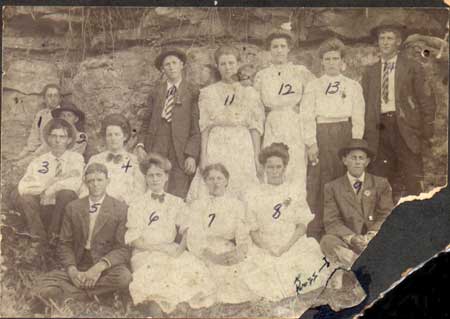
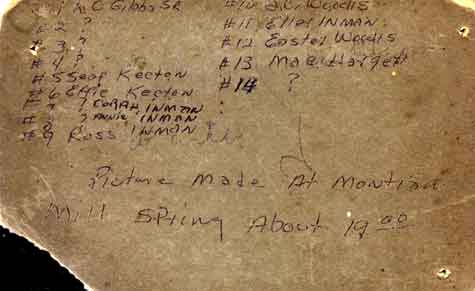
My mother’s family lived
in the store house about 1910. We think the Blankenship family lived in it at
one time. About 1915, a sawmill company came into the area and used this for
headquarters. Mr. Sam Williams ran a store for them. Some of his family are
still in this area.
Around 1920, this
building was moved to Barton, Alabama by Mr. Sam Williams we think. Some time in
the 1950’s this building burned. That was the last of Mountain Mills.
Return to History